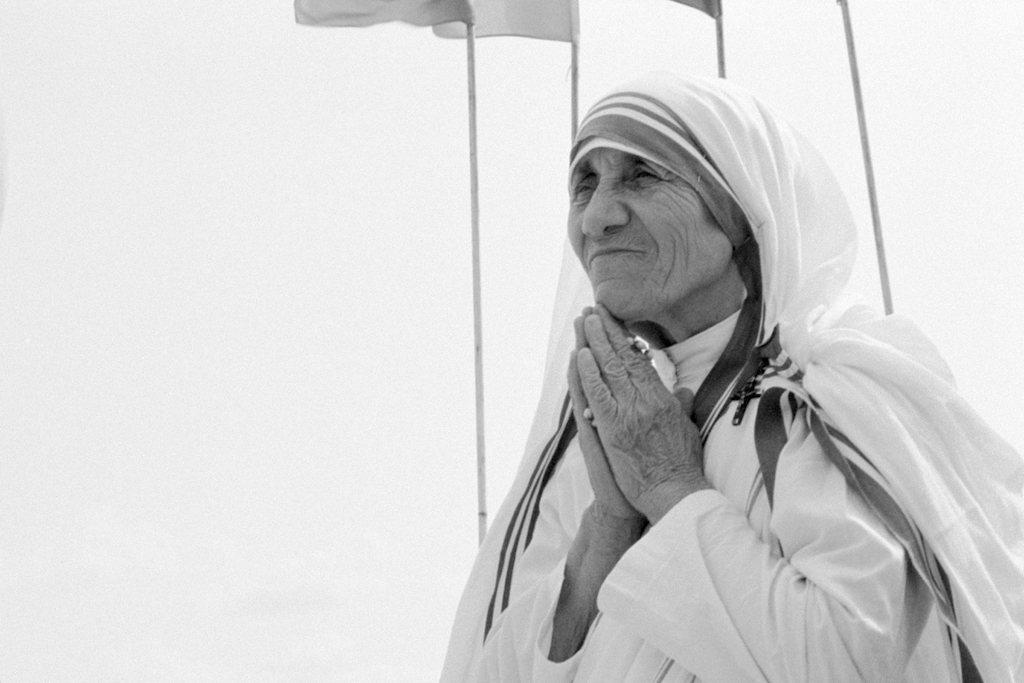In one month, Pope Francis will declare Mother Teresa of Kolkata the Church’s newest saint. While most of us are familiar with her public work in India and elsewhere, it is good to learn more about this holy woman.
Born Agnes Gonxha Bojaxhiu in 1910, Mother Teresa was Albanian by birth, but lived most of her early years in Yugoslavia. At the age of just 18, she joined the Sisters of Loreto, an Irish order of teachers. During those years, she worked in India. However, God called her to something more.
Mother Teresa (the name she received when she entered the convent of the Loreto order) received a call from Christ to serve the poorest of the poor. In order to do that, she needed to leave her beloved Loreto Sisters and found a new order. She was determined that this order live among the poor, and that these sisters would live as the poor did: with as few possessions as possible.
Founding this new order took a great deal of determination. Mother Teresa was a tiny woman, with a warm smile and a heart for service. She was also one very determined lady. Although it took several years, she was finally given permission from the bishop to found her order: the Missionaries of Charity. These new sisters would wear simple saris, just like the women they would serve. The sisters would have only two habits: one to wear and another to change into when the first was dirty. They would wear sandals and carry rosaries. That was to be the sum total of their possessions. Mother Teresa felt strongly that in order to serve the poor, they must be poor themselves.
Her sisters would go out into the streets of Kolkata daily, feeding the poor, offering simple medicine for those who were ill and gathering the children for teaching and religious education. In twenty years, the order grew, as did their work.
Trusting entirely in God’s providence to sustain their work, in only three years they had built a motherhouse, established an orphanage, and set up a program to serve lepers throughout the city of Calcutta. Twelve years later they opened their first home outside of India. By 1971 the order ran 50 homes throughout the world, and many more were yet to come. Mother Teresa once told several sisters who were about to begin a new mission, “If there are poor people on the moon, we will go there.”
The work of the Missionaries of Charity was not without detractors. Many in India believed that the Sisters had set out to Christianize a Hindu nation. Others believed that the Sisters’ work was not enough: their hospices were not up to modern health standards, and they did little to actually help the poor, beyond offering food, simple medications and shelter. Through it all, Mother Teresa simply worked, serving her beloved poor.
In 1979, Mother Teresa was awarded the Nobel Peace Prize for her work. In her acceptance speech, she implored those in the West to spread her mission of love themselves:
I want you to find the poor here, right in your own home first. And begin love there. Be that good news to your own people. And find out about your next-door neighbour – do you know who they are? I had the most extraordinary experience with a Hindu family who had eight children. A gentleman came to our house and said: Mother Teresa, there is a family with eight children, they had not eaten for so long – do something. So I took some rice and I went there immediately. And I saw the children – their eyes shinning with hunger – I don’t know if you have ever seen hunger. But I have seen it very often. And she took the rice, she divided the rice, and she went out. When she came back I asked her – where did you go, what did you do? And she gave me a very simple answer: They are hungry also.
Following her death in 1997, Pope John Paul II waived the five year period normally required for the process of canonization. He declared her “Blessed” in 2003 and Pope Francis will declare her a saint on September 4, 2016. The tiny woman who began her work with a call from God left a worldwide legacy that touched the lives of millions. However, she had only one focus: to serve God.
Mother Teresa’s spiritual vitality can be described with these words. “Don’t search for God in faraway lands. He is not there. He is close to you. He is with you. Just keep that lamp burning, and you will always see him.”
In the coming weeks prior to her canonization, we will explore more of the life and works of Mother Teresa. for now, let us take her advice and focus on the God who is with us here and now.
